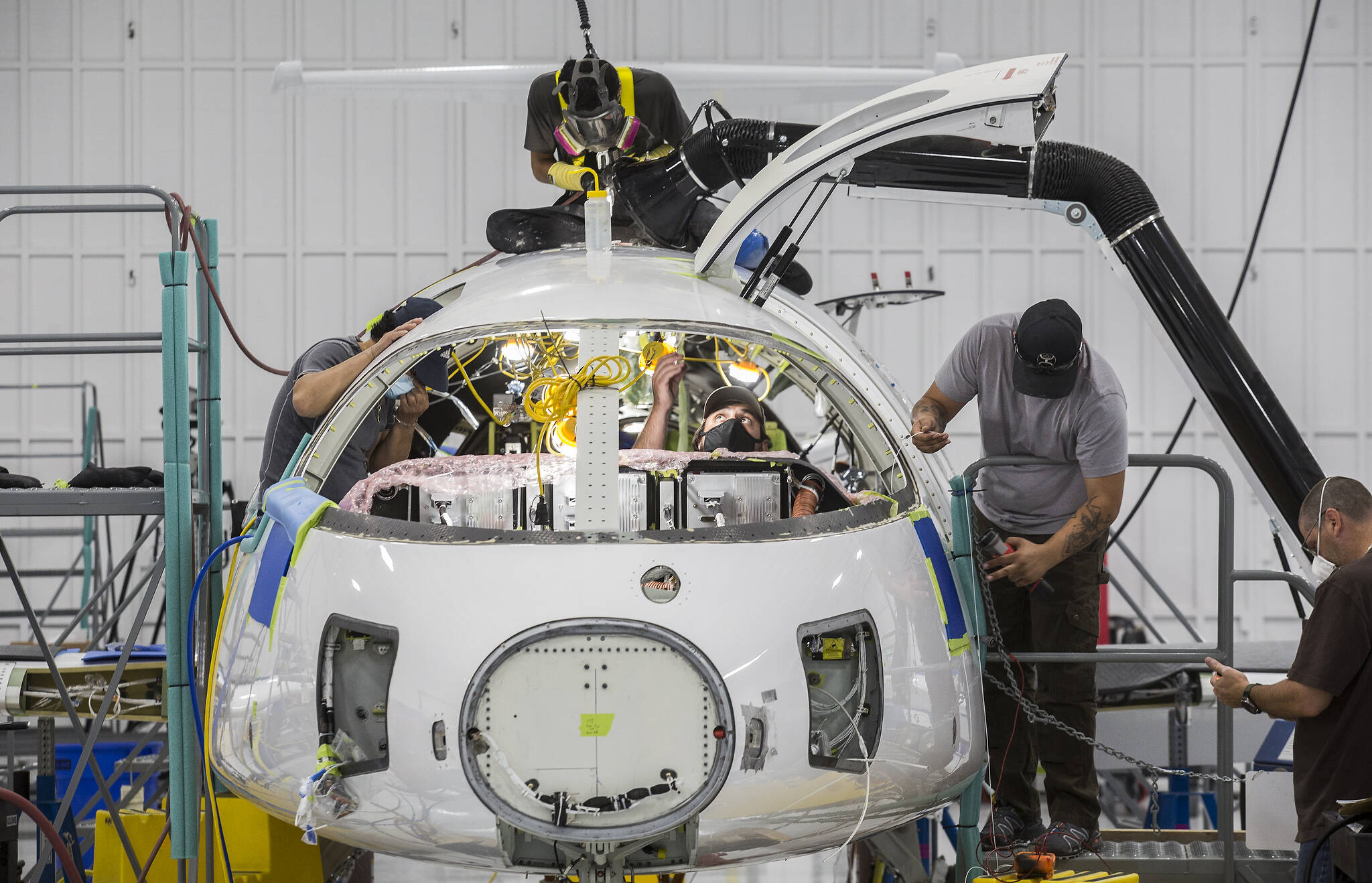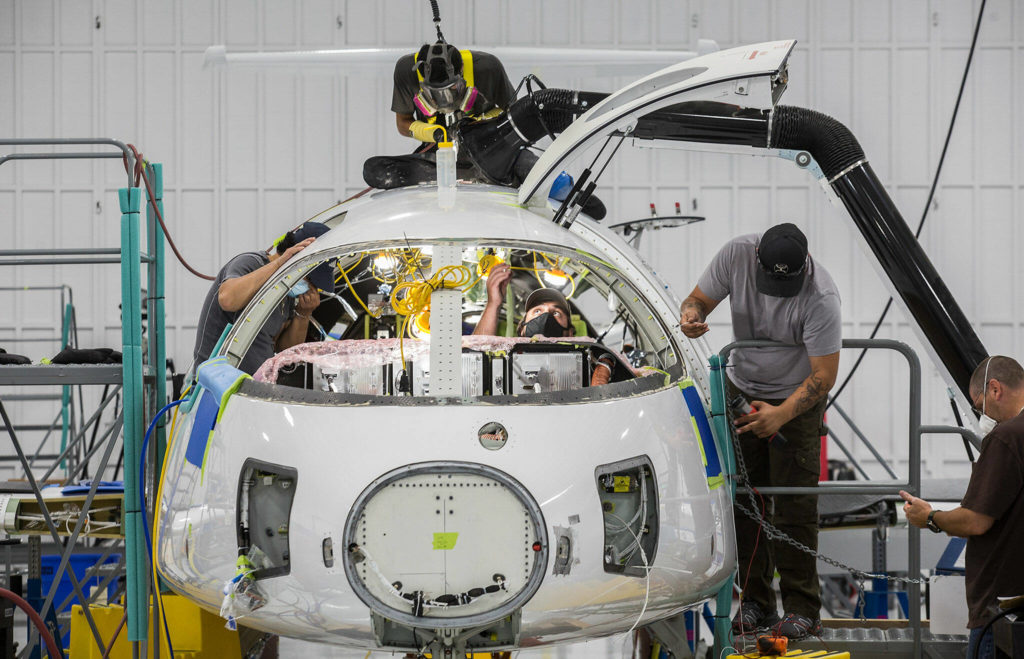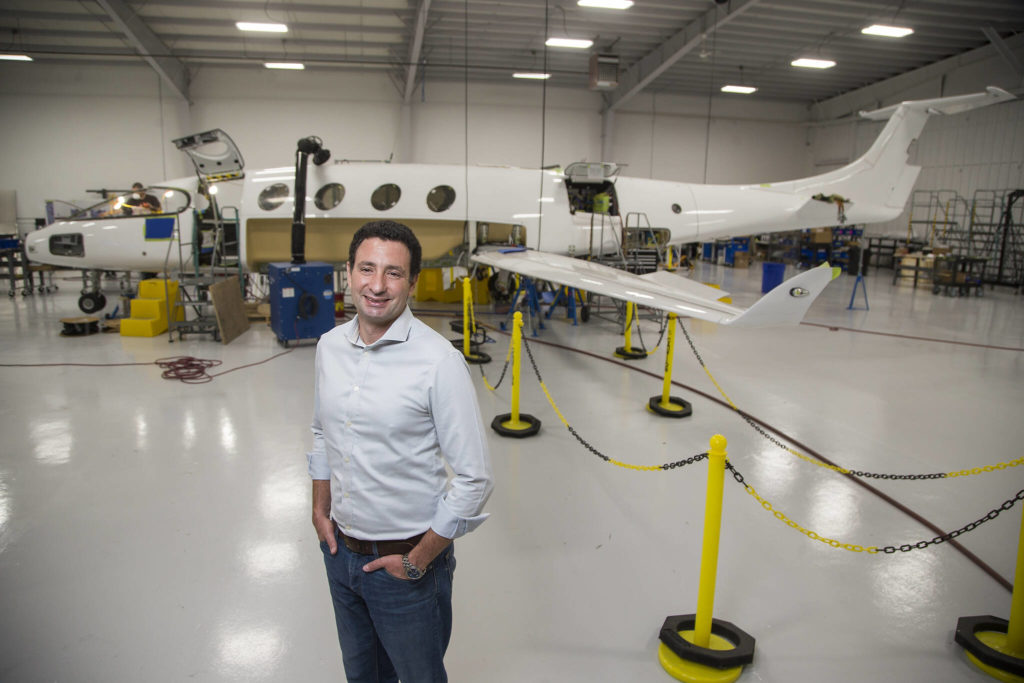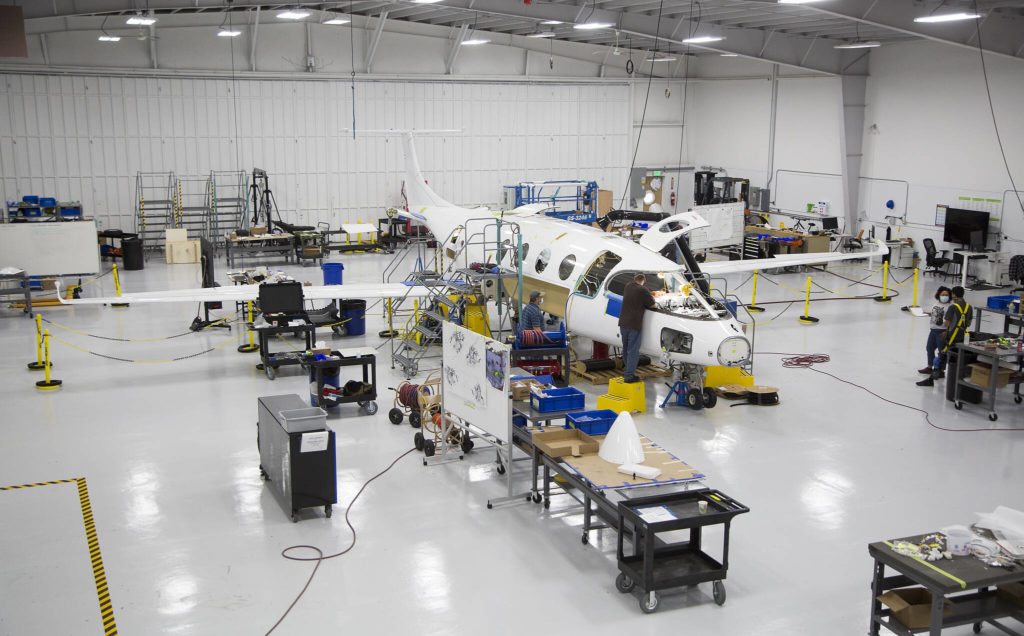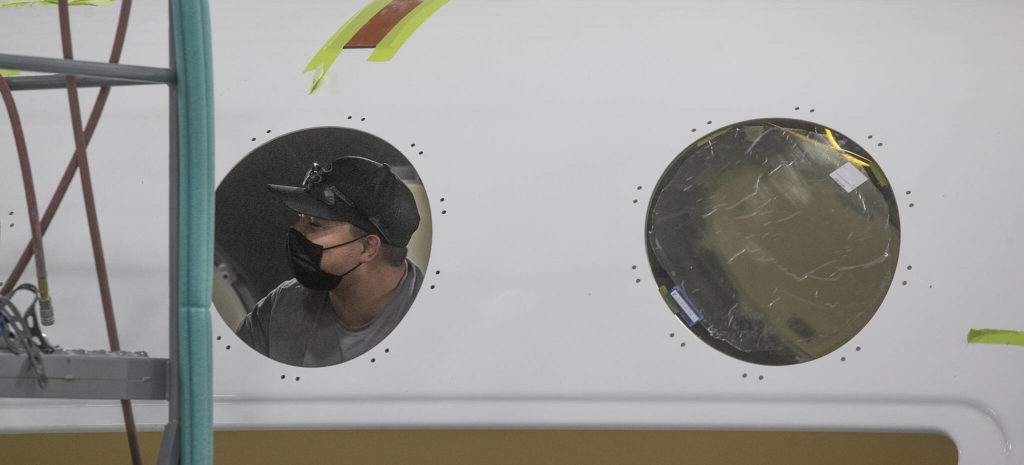ARLINGTON — It’s crunch time for Omer Bar-Yohay, CEO and co-founder of Eviation Aircraft, which is developing an all-electric airplane.
Minutes count.
In the conference room at the company’s Arlington headquarters where Bar-Yohay paused to describe the company’s next move, an enormous digital screen displayed the time in foot-high digits, counting down the minutes until his next appointment.
Eviation plans to test fly its all-electric airplane this year.
“Testing is going to plan. We will be flying the plane this year, weather permitting,” said Bar-Yohay, who co-founded the company six years ago in Israel.
But before that can happen, dozens of tests must be completed.
“Every system and subsystem of the aircraft from structures to electronic performance and the batteries, the motor — all are being tested separately and then they’re tested together for functionality,” said Bar-Yohay, who studied physics at The Hebrew University in Jerusalem.
In July, Eviation unveiled its design for the production version of the fully electric, nine-passenger airplane, known as Alice.
Named after the main character in Lewis Carroll’s book, “Alice’s Adventures in Wonderland,” the 57-foot commuter plane has a 63-foot wingspan, a targeted range of 500 miles and a top cruising speed of 287 mph. It seats two crew members.
Two electric motors, designed and built by a sister company, Everett’s magniX, connect to the plane’s onboard lithium-ion batteries and power the aircraft.
The two aerospace firms, both working to develop fully electric aircraft, moved to Snohomish County last year and have teamed up to design the new plane.
Eviation occupies three hangars at the Arlington Municipal Airport. MagniX is housed in a 40,000 square-foot building in south Everett near Paine Field.
Alice produces no carbon emissions and is expected to cost a fraction to operate per hour, the company advertises.
Without ever having flown, Alice has already drawn considerable interest.
In August, DHL Express, the global package delivery firm, ordered 12 of the planes, which will be configured to carry cargo and have a payload capacity of 2,600 pounds.
To reduce weight, more than 90% of Alice’s airframe is made of composite materials, lighter and stronger than aluminum. Still, the airplane tips the scales at 16,500 pounds. Nearly half of that weight, 8,200 pounds, is taken up by two battery packs that are mounted flush with the fuselage on either side of the aircraft.
Eviation says it has new and prior commitments from commercial passenger airlines, but declined to disclose details. In 2019, Eviation announced that Cape Air, which operates scheduled passenger flights in the Northeast, Midwest and other locations, had agreed to a purchase option for several planes.
Electric aviation
Battery-powered electric airplanes have been around since the 1970s, but so far haven’t proven practical as anything other than experimental aircraft.
Despite advancements, lithium-ion batteries “remain both bulky and heavy,” Airways Magazine noted this month. Even short distance flights of 500 miles or less “require enough power to make current batteries impractical,” Airways said.
But a less-than-rosy prognosis hasn’t discouraged hundreds of companies across the globe from pursuing longer range, all-electric flight. The focus ranges from fully electric lightweight sport airplanes, to commuter planes, to electric vertical takeoff and landing aircraft, known as eVTOL.
Their innovations could help reduce the aviation industry’s growing carbon footprint. Aviation is responsible for 9% of transportation emissions in the United States and 3% of the nation’s greenhouse gas production, according to the Environmental Protection Agency.
Founded in 2015, Eviation set out to design and build a battery-powered commuter aircraft with an all-electric propulsion system.
In 2019, the company unveiled “Alice”, a nine-seat prototype, at the Paris Air Show. A few months later, Eviation and Alice experienced a setback.
In January 2020, the prototype caught fire after “a lithium battery used to power (the) experimental aircraft exploded during a ground test at Prescott Airport in Arizona,” according to a Federal Aviation Administration report.
Bar-Yohay recently told The Times of Israel that the fire was caused by a “ground-based battery pack providing power for a systems test,” not the airplane’s lithium battery pack. “These batteries that caught fire were not the aircraft flight batteries — not even the same type of battery,” Bar-Yohay said.
These days, the newest version of Alice sits at the center of an enormous, brightly lit hangar at the Arlington Municipal Airport. It is attended to by a score of technicians, surrounded by test equipment and serenaded by a playlist of upbeat, rock ‘n roll tunes.
With a light, sleek wing and a flat underbelly intended to increase lift, Alice stands 13 feet tall.
“To carry the weight and volume of the battery, we really needed to reinvent how the weight is distributed,” Bar-Yohay said of the fuselage’s unusual shape.
Airplane passengers are expected to enjoy the views offered by a bank of oversized elliptical windows.
When the maiden flight of the world’s first all-electric commuter aircraft takes place, the event is expected to draw scrutiny from aviation experts, federal regulators, airline executives and media from around the world.
One person who will be paying particularly close attention will be Richard “‘Pat” Anderson, professor of aerospace engineering at Embry-Riddle Aeronautical University in Daytona Beach, Florida.
Battery weight is a critical factor in the design of electric aircraft, Anderson said in an interview with The Daily Herald.
To produce the energy equivalent of one pound of aviation fuel, “you need 27 pounds of batteries,” said Anderson, who also serves as director of the university’s Eagle Flight Research Center.
The ratio imposes limits on how much a battery powered-electric airplane can weigh — and still get off the ground — and determines how far it can fly. Until battery technology improves, he foresees “a hybrid period for aviation” in which both batteries and conventional aviation fuel provide power.
“I may come off sounding negative, but I am very pro-electric aviation,” Anderson said.
“It’s greener. It promises lower emissions and lower noise emissions,” added Anderson, who eagerly awaits Alice’s first flight. “I just think we have to figure out the battery weight issue, and I think that will simply take some time.”
Runway debut
Both magniX and Eviation are subsidiaries of the Clermont Group, a private investment firm based in Singapore.
Roei Ganzarski, the CEO of magniX is also the chairman of Eviation’s board of directors.
Founded in 2009, magniX has already had considerable success with its electric propulsion systems.
In 2019, the company partnered with Harbour Air, a commercial seaplane carrier based in Vancouver, British Columbia.
One of Harbour Air’s seaplanes, a six-passenger, single-engine DHC-2 de Havilland Beaver, was retrofitted with a 750-horsepower magniX motor.
In December 2019, the electric-powered seaplane completed a 15-minute test flight on the Fraser River in British Columbia, marking the first successful flight of a fully electric, commercial-sized airplane.
Now it’s Alice’s turn.
But unlike the seaplane, she’s no retrofit. Alice is a clean sheet design that has been specifically engineered to support a battery-powered electric propulsion system.
And she’s about to make her runway debut, Bar-Yohay said.
In a few weeks, onlookers may catch sight of the gleaming white plane as it emerges from the hangar to undergo ground and taxi tests at the Arlington airport, he said.
Covering a lot of territory
Alice’s target range, 500 miles, covers a lot of territory: 45% of all scheduled commercial flights are 500 miles or less, according to OAG, an aviation and travel data firm.
The distance encompasses point-to-point travel in some of the nation’s major metropolitan clusters: New York-Philadelphia-Washington D.C; Seattle-Portland-Spokane; Dallas-Houston-Austin and Orlando-Miami-Nassau. Alice’s lithium batteries would require 30 minutes or less to charge per flight hour, the company said.
Fuel costs are usually an airline’s largest expense — roughly half the cost of operating an airplane is related to fuel and engine maintenance, according to OAG.
Eliminate even a modest percentage of that cost and you’ve got potential customers.
In fact, airplane manufacturers regularly market new airplanes based on fuel savings of 15% to 20% compared to previous generation airplanes.
“We estimate it will cost about $250 to $350 per flight hour to operate. A turboprop with similar performance costs between $1,200 and $2,000 per flight hour,” Bar-Yohay said.
If Alice can do what its designers say it can do — operate at a fraction of the cost of a conventional airplane and achieve its target range — it will not only generate interest and awe but orders and revenue.
In addition, its success could diversify Snohomish County’s and the region’s traditional aerospace industry.
Arlington Mayor Barb Tolbert said that Eviation has made a big effort to connect with local aerospace companies.
“They asked for a complete list of Snohomish County aerospace suppliers when they were negotiating with us to move in,” Tolbert said. “They want to build a local supply chain for their product.”
Eviation currently employs 120 people, but expects to see those numbers jump if it obtains federal regulators’ approval for Alice to enter service. The company is targeting 2024 for that approval. If that happens, the airplane would go into commercial production. The company plans to locate its production facilities in Arlington.
When Eviation was scouting airports for the right location, it zeroed in on the Arlington airport. The airstrip largely serves the general aviation community, which doesn’t include scheduled commercial and cargo flights. That means the company’s operations wouldn’t conflict with commercial flights. Plus, there is room to spread out, said Jessica Pruss, Eviation’s vice president of sales.
“As we scale and grow, we have room to build buildings on the the other side of the runway — that was a selling point,” Pruss said. “Five to 10 years from now we’ll have room to grow production.”
Inside the Arlington hangar, the minutes are ticking down as Alice’s maiden flight draws closer. No date has been set, except for an end-of-the-year goal, Bar-Yohay said.
“At a meeting the other night, I told everyone that the next couple of weeks are going to be a sprint,” Bar-Yohay said.
The staff didn’t miss a beat, he recalled, and shot back, “It’s been a sprint for the last six years!”
Janice Podsada; jpodsada@heraldnet.com; 425-339-3097; Twitter: JanicePods
Talk to us
> Give us your news tips.
> Send us a letter to the editor.
> More Herald contact information.
